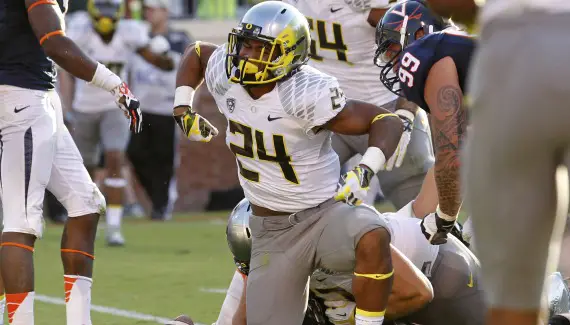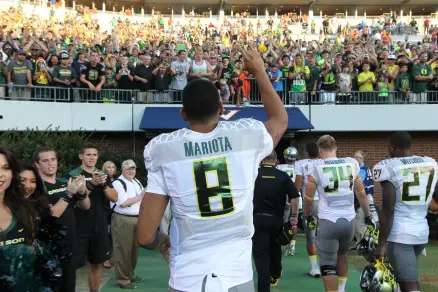Andrew Shurtleff
The bad news: Marcus Mariota is struggling with accuracy, the inside run game looked pretty pathetic against a sizable defensive line, Byron Marshall couldn’t find any room, offensive play calling was highly questionable and third down conversions didn’t come as easily this time around.
The good news: none of that matters at this point. As one pundit put it on a postgame radio show “when I played, if we beat a team 59-10, we would have been the best thing since sliced bread.”
Only in this age of Oregon dominance, when perfection is so rampantly expected, that a 59-10 win over a power-conference school seems somewhat underwhelming and cause for some concern.
The simple truth, at this point of the season, is that a seven-touchdown margin of victory is something to be celebrated, not nit-picked. Right now, the speed and depth of Oregon is the program’s greatest advantage. Yet, aerial accuracy and internal rushing gains, need to be developed and that will come with time.
Against Virginia, after an effort of poor inside rushing (especially from Marshall), it was quickly subsidized by huge plays on the outside. As the quality of opponents increases over the season, that speed advantage on the outside may dip and more success between-the-tackles will be required.
So, now is the time for the Ducks to work out the kinks of the inside zone-read and for Mariota to find his passing rhythm. The game against the Cavaliers was only the second of the season, and the coaching staff still needs time to test different plays with different players against opponents.
The great news: aside from a huge point-tally and stout defensive performance on the road, is that the questions have feasible answers.
The bad: A 14-of-28 passing outing for Mariota was a career low on Saturday and wasn’t great against Nicholls.
The good: Some of the incompletions were a result of a bevy of drops by Colt Lyerla, and the play calling from Scott Frost, that set up Mariota for failure when the inside running failed. As the inside game gets better and play calling improves, his completion percentage will rise, as other teams start biting on the play action.
The bad: The inside run looked pretty poor. Marshall averaged 2.1 yards per carry with the longest being 5 yards. This was a product of subpar run blocking, a large Virginia defensive front, more deliberate handoffs rather than true option plays and unusual play calling.
The good: Thomas Tyner arrived and looked buff and ready to contribute. He has the same size as Marshall but with a lot more speed. This isn’t to say that Tyner will overtake Marshall, but he will see more carries and likely has more nifty moves inside. The run blocking will improve with as the season progresses.
An explanation for some of the more conservative, true running plays in repetition from Frost may have been deliberate to give the O-Line some extended reps. The coaches are likely running some scripted sets to get a sense of how the Ducks will perform in different situations. Once the coaches figure out what the team is capable of doing, the offensive calls will play to Oregon’s strengths.
The bad: Third down was not nice to Oregon, as UO went 3-for-10 on the crucial down.
The good: This is a quick fix when the play calling begins to change. As mentioned earlier, much of the game planning seemed to not fit certain situations (running on third and long, short passes, etc.), but this was likely purposeful trial and error. When the Ducks must have 3rd-down conversions, more sensible scheming will allow it.
Luckily for UO, our next opponent, Tennessee, a historically-elite program, is trying to rebuild. While the Volunteers will likely not be an extremely tough challenger — though they provide a nice test, bringing an SEC defensive line for Oregon to push against with the inside running game. If Oregon comes anywhere close to the 49-point win it scored against Virginia, the Ducks’ defense will seal the deal.
________________________________________________
Announcements
*Check out our new pregame opponent analysis on Saturday mornings. Our analysis will be unlike any other, so learn what to watch for before the game on Saturday!
*Want some College Football humor? Check out FishDuck.com‘s FIRST GIF! (Click here) Pass it along!
*If you would like to join the other 80+ volunteers at FishDuck.com, and have five hours a week to donate . . . we have slots open for volunteer Editors, Writers, Analysts, Photo Archivists and Social Media Associates. Can you help us manage people? Consider our volunteer Sales Manager and HR Manager positions and give some time each week to help young associates learn! E-mail us at charles@fishduck.com
Related Articles:
Chip Kelly Update: Everything's Good Again ...
Chip Kelly Update: Wailing and Gnashing of Teeth
Shock and Awe -- The Oregon Ducks' Football Hangover Effect
Despite Lopsided Score, Georgia State "Never Stopped Believing"
Hope Springs Eternal for Ducks
Incompetent Pac-12 Officials: How Do You Miss ALL of THIS?
Jackson Long is a graduate of the University of Oregon’s school of journalism. A sports journalist for over six years, Jackson has accumulated over 300 published works across a multitude of publications and platforms. He has been a beat reporter covering the University of Oregon for football, men’s basketball and track and field. As a journalist, he provided live coverage from events including: the Fiesta Bowl in Glendale, Pac-12 Men’s Basketball Tournament in Las Vegas, Rounds 1 and 2 of March Madness in San Jose and the Sweet 16 and Elite 8 in Indianapolis, all in 2013. He also covered the NCAA Track and Field Championships in Eugene that year. With an impressive portfolio of works mainly focused on long-form, feature style writing, Jackson hopes to have a career with a major sports media purveyor.



